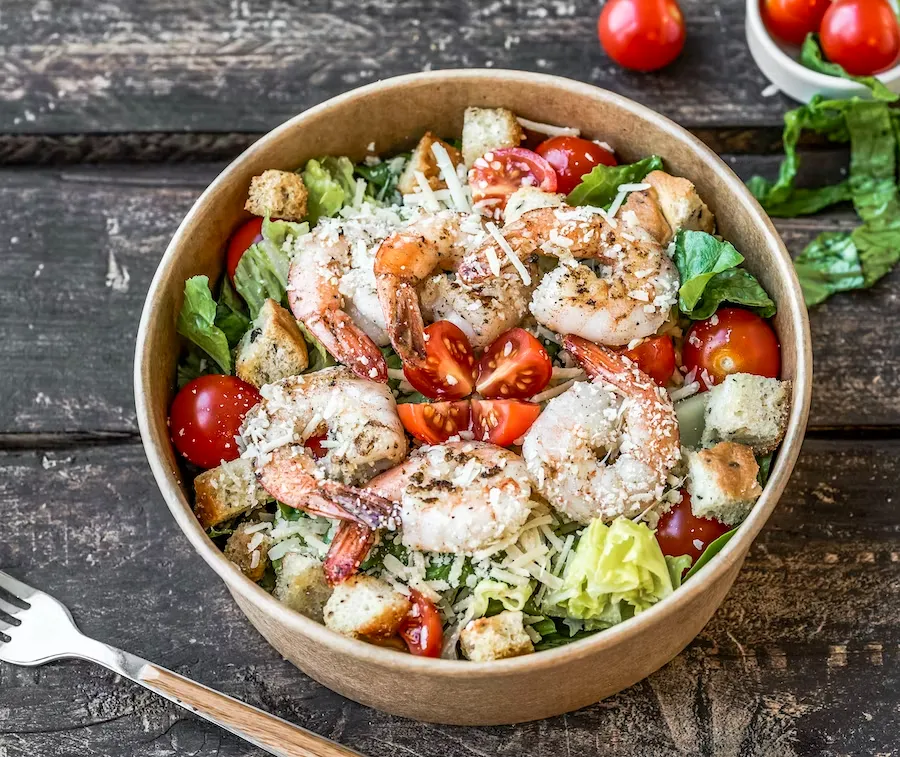1. Psilokomeni Salad: A Greek Culinary Symphony
Psilokomeni, an exquisite Greek creation, transcends the ordinary salad experience, offering a harmonious symphony of flavors that dance on the taste buds. This salad, a celebration of freshness and simplicity, weaves together romaine lettuce, scallions, dill, and an assortment of essential ingredients. The romaine lettuce is not just washed but meticulously prepared, sliced thinly to provide a delicate texture. The scallions and dill, cut into perfect pieces, contribute to the overall visual and gustatory appeal.
The dressing, a careful blend of olive oil, red wine vinegar, salt, and black pepper, elevates Psilokomeni to a culinary masterpiece. Each element is thoughtfully chosen to create a perfect balance, ensuring that no single flavor overpowers the others. Psilokomeni, which translates to “thinly sliced,” is a nod to the meticulous preparation of the vegetables that grace this Greek delight. It’s not just a salad; it’s a cultural expression of Mediterranean freshness.
2. Mermizeli: Kalymnian Gastronomy Unveiled
From the enchanting island of Kalymnos emerges Mermizeli, a salad that encapsulates the essence of Kalymnian gastronomy. At its heart are krithini kouloura, local round barley rusks that undergo a delicate transformation. These rusks, softened in water, become the canvas upon which a culinary masterpiece is painted. The combination of tomatoes, onions, cheese (often cream cheese or feta), and the generous drizzle of olive oil creates a flavor profile that is both robust and nuanced.
But Mermizeli doesn’t stop there; it invites additional characters to the gastronomic stage. Greek sardines, capers, olives, cucumbers, sea squirts, and aromatic herbs native to the island add layers of complexity. In the traditional taverns of Kalymnos, each rendition of Mermizeli carries a unique twist, a culinary signature that reflects the soul of the chef and the spirit of the island.

3. Lahanosalata: Winter’s Embrace in Greek Cabbage Salad
As winter blankets the Greek landscape, Lahanosalata emerges as a culinary ode to the season. Finely shredded red or white cabbage, dressed with a combination of olive oil and lemon juice, becomes the canvas for this winter delight. The choice of cabbage, with its robust texture and earthy flavor, is a testament to the Greeks’ ability to celebrate seasonal produce.
But the beauty of Lahanosalata lies in its adaptability. This is a canvas open to interpretation, allowing for the addition of different spices, herbs, or supplementary vegetables such as carrots or fennel. The option to use yogurt-based or mayonnaise-based dressings provides further flexibility, making Lahanosalata a versatile companion to various main courses during the colder months.
4. Askordoulakous: Cretan Delight with Leopoldia Comosa
From the rugged landscapes of Crete comes Askordoulakous, a dish that celebrates the bulbs of Leopoldia comosa, a plant that thrives in the wild, mountainous terrains of the island. The bulbs, meticulously cleaned, open doors to a world of culinary possibilities. They can be cooked, stewed, pickled, or served fresh, each preparation offering a unique sensorial experience.
In its salad form, Askordoulakous stands as a meze, a prelude to the diverse flavors that will follow. Whether dressed up with olive oil and lemon juice or accompanied by vinegar, this Cretan delight finds its place on tables alongside various meat dishes. It’s a celebration of the untamed beauty of Crete, a gastronomic journey through the island’s bounty.
5. Srpska Salata: A Serbian Twist on Bulgarian Shopska Salad
Srpska Salata, a variation of the well-known Bulgarian Shopska Salad, shares its roots but carves its path in the culinary landscape. Tomatoes, cucumbers, raw or roasted peppers, and onions join forces to create a vegetable ensemble that captures the essence of summer. Seasoned with salt and pepper, and graced with a drizzle of oil and vinegar, Srpska Salata distinguishes itself by omitting the cheese, allowing the vibrant flavors of the vegetables to shine.
This refreshing salad, a favorite during the summer months, unfolds like a culinary love letter to the season. It embodies the simplicity and freshness that define Balkan cuisine, making it a staple on tables from Belgrade to Sofia.

6. Salată de Sfeclă: Romanian Refreshment with Beetroots
Salată de Sfeclă, a refreshing Romanian salad, centers around the vibrant beetroot. Boiled to tender perfection, the beetroots become the focal point of this culinary creation. Grated horseradish, oil, vinegar, and salt join the stage, contributing to a flavor profile that is both bold and invigorating.
But the true beauty of Salată de Sfeclă lies in its versatility. Mustard seeds or cumin seeds can be added for an extra layer of complexity, allowing the salad to adapt to varying taste preferences. Whether served warm or chilled, this light salad stands as a testament to Romania’s culinary heritage, celebrating the vibrant flavors of the region.
7. Salată de Castraveți: Romanian Cucumber Elegance
Originating from Romania, Salată de Castraveți is a traditional cucumber salad that exudes elegance. Fresh cucumbers, onions, olive oil, salt, tarragon, and cider vinegar come together to create a symphony of flavors. The cucumbers, sliced thinly and coated with a mixture of vinegar and oil, present a refreshing summer salad that is both crisp and flavorful.
Timing is key with Salată de Castraveți. It should be served immediately to ensure the cucumbers retain their crunchiness, offering a delightful contrast to the succulent main dishes. This Romanian culinary gem, with its simplicity and sophistication, adds a touch of elegance to any table.

8. Tonosalata: Greek Tuna Extravaganza
Tonosalata, a Greek-style tuna salad, is a culinary extravaganza that brings together the simplicity of preparation with the rich flavors of Greece. Chunks of tuna, accompanied by various diced vegetables, create a delightful medley of textures and tastes. The choice of additional elements, such as capers, olives, and herbs, adds layers of complexity to this Greek masterpiece.
Whether coated in a creamy dressing or simply seasoned with olive oil and lemon juice, Tonosalata is a testament to the versatility of Greek cuisine. Best served chilled, it invites diners to savor the freshness of the Mediterranean, transporting them to the azure coasts and sun-drenched landscapes that inspire its creation.
9. Salată Orientală: Romanian Potato Bliss
Salată Orientală, a Romanian potato salad, invites diners on a journey through the flavors of Eastern Europe. Boiled potatoes, onions, hard-boiled eggs, and olives unite to form a flavorful ensemble. Seasoned with a blend of oil and vinegar, this salad is a canvas for culinary creativity.
Variations of Salată Orientală abound, with some incorporating mayonnaise, pickles, pickled red peppers, or additional vegetables. Light yet bursting with flavor, this versatile salad can be enjoyed warm or chilled. Garnished with whole olives, parsley, and onion rings, it stands as a celebration of Romania’s diverse culinary traditions.
10. Salată de Varză: Romania’s Crunchy Cabbage Classic
Salată de Varză, a traditional Romanian salad, brings the crunchiness of shredded white cabbage to the forefront. The combination of cabbage, olive oil, salt, pepper, and lemon creates a tangy and peppery delight. However, the preparation of this classic dish involves a unique process.
The cabbage is initially mixed with salt and set aside, allowing the salt to extract moisture and soften the cabbage. Once ready, the cabbage is squeezed, releasing excess moisture, and then combined with the remaining ingredients. The result is a salad that embodies the ingenuity of Romanian culinary techniques, offering a delightful accompaniment to various meat dishes.
conclusion
Mediterranean salads are not merely dishes; they are gateways to the cultural and culinary richness of their respective regions. Whether Greek, Kalymnian, Cretan, Serbian, Romanian, or a fusion of influences, each salad is a story told through flavors, inviting enthusiasts to embark on a gastronomic journey through the Mediterranean’s diverse and vibrant tapestry.
Read Also:- Top Reusable Salad Containers For Lunchtime Prep




